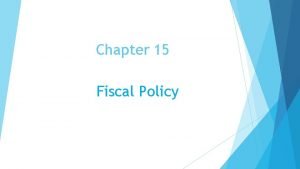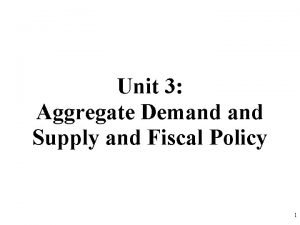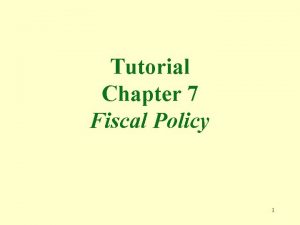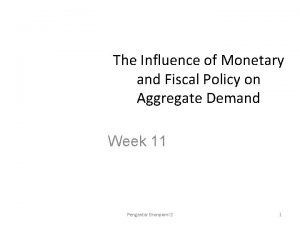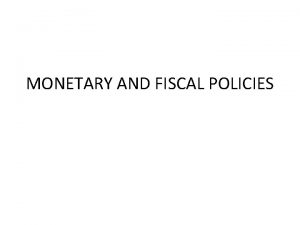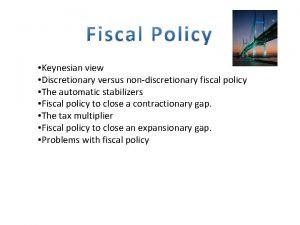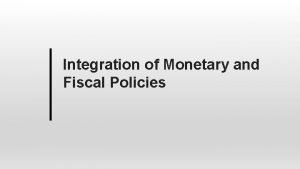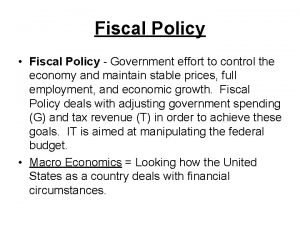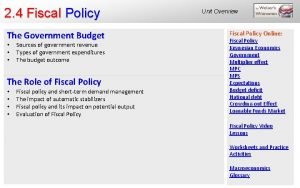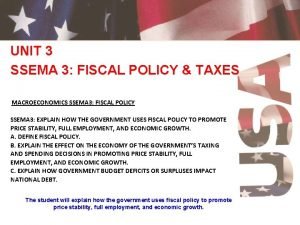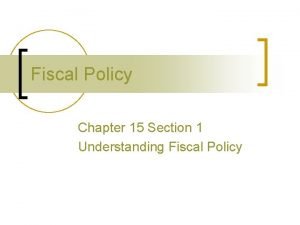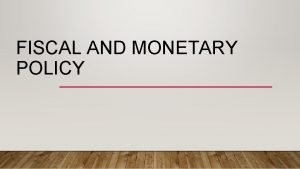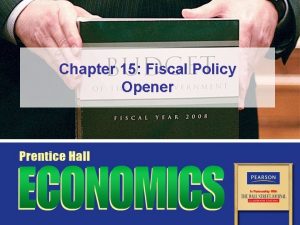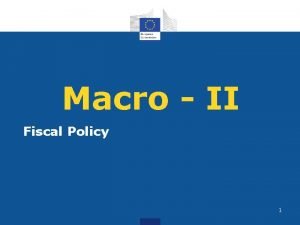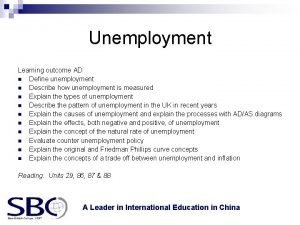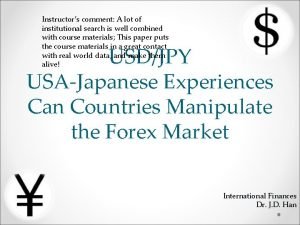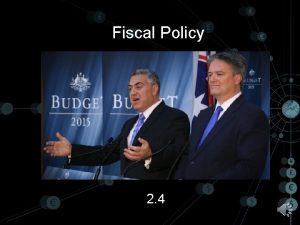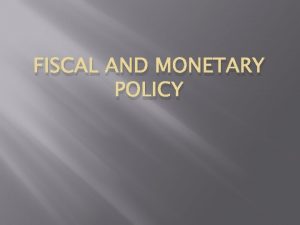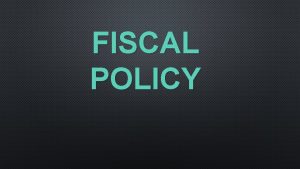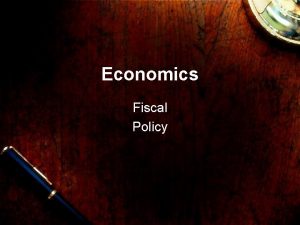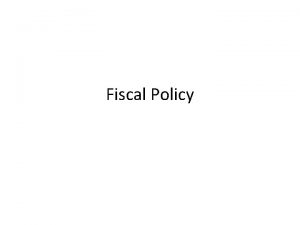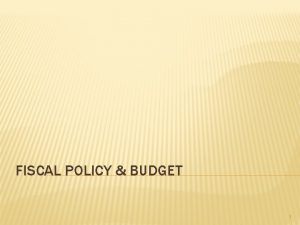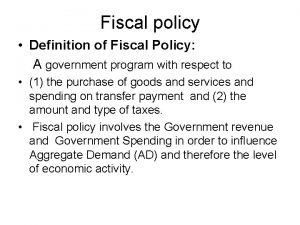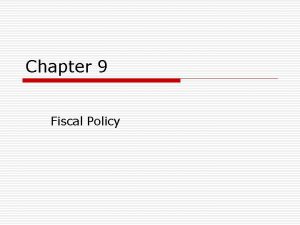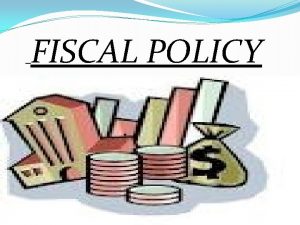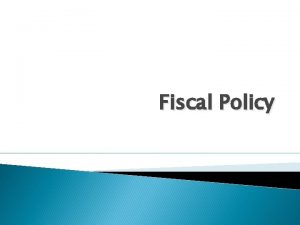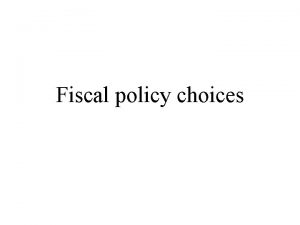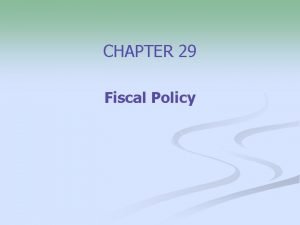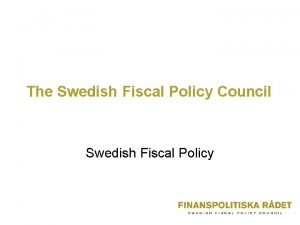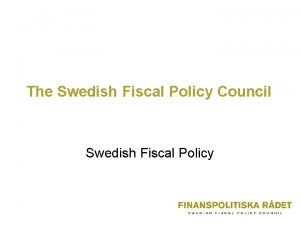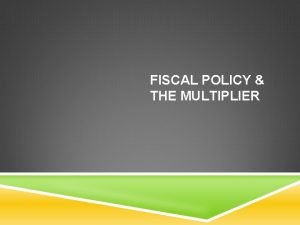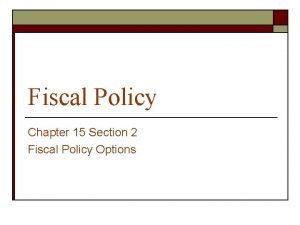Fiscal Policy 2 4 Fiscal Policy Definition Purpose





























- Slides: 29

Fiscal Policy 2. 4

Fiscal Policy • Definition • Purpose (demand-side management) • The Budget (source of revenue, types of spending, classification) • How it works • Evaluation of Fiscal Policy

Fiscal Policy – How it works Changes AD Fiscal policy can affect C, I, and G G is changed directly by the government e. g. spend $6 billion on roads C can be changed by taxation changes e. g. an increase in tax reduces disposable income ↓C

Fiscal Policy – How it works Changes in AD I (investment) can be affected by changes in corporate tax e. g. ↓ corporate tax rate ↑ return on investment ↑I

Fiscal Policy – How it works Closing a recessionary gap (Expansionary fiscal policy) Price level SRAS Pl 1 Ple ↑ Investment • Business tax cut AD 1 AD 0 Increase in AD ↑ Consumption • Personal income tax cut • Transfer payment (welfare) increase Ye Yf ↑ Government • Increase in current expenditures • Increase in capital expenditures real GDP

Fiscal Policy – How it works Closing a recessionary gap (Expansionary fiscal policy) Price Level AS Model differences Moneterarist/New Classical • ↑ AD, ↑ Price level Always Keynesian • ↑ AD, ↑ Price level Not always Pl 1 Ple AD 1 0 Ye Ye 2 AD 2 Ye AD 1 Yf real GDP

Fiscal Policy – How it works Closing an inflationary gap (Contractionary fiscal policy) Price level SRAS Ple ↓ Investment • Business tax rise Pl 1 AD 1 0 Decrease in AD ↓Consumption • Personal income tax rise • Transfer payment (welfare) decrease Yf Ye ↓ Government • Decrease in AD current expenditures • Decrease in capital expenditures real GDP

Fiscal Policy – How it works Closing an inflationary gap (Contractionary fiscal policy) Price Level AS Model differences Keynesian • ↓ AD, effect on real GDP depends on position on AS • Same decrease in AD, significant difference in real GDP decrease • Price level not always affected Ple Pl 1 AD 2 AD 1 AD 2 0 Y 2 Y 1 Yf Ye real GDP

Fiscal Policy – How it works Closing an inflationary gap (Contractionary fiscal policy) Price Level AS Model differences Keynesian • ↓ AD, effect on real GDP depends on position on AS Ple Pl 1 AD 2 0 Yf Ye real GDP

Fiscal Policy – How it works Predominantly a demand-side policy, but can affect supply Impact on potential output Indirect impacts Fiscal policy is used to lessen short-term fluctuations. A more stable economy inspires confidence for investment in technology and capital goods.

Fiscal Policy – How it works Impact on potential output Direct impacts - Government money allocated to infrastructure and research & development - Government money to invest in human capital

Fiscal Policy – How it works Impact on potential output Direct impacts - Lower business taxes to encourage investment in research and development

Fiscal Policy – How it works Both Demand Supply Increase Price level LRAS 1 SRAS 1 Ple AD 1 AD 0 Ye Ye 1 Real GDP

Fiscal Policy – How it works AS 1 Price Level Both Demand Supply Increase AS 2 AD 1 0 Yf 1 Yf 2 real GDP

Fiscal Policy – How it works Automatic stabilisers Factors that help stabilise the economy without the government having to pull any policy levers Unemployment benefits As ↓AD, ↓ production, ↓ real GDP, ↓ employment, ↓ C BUT ↑ unemployment benefits, lessens impact of ↓ C

Fiscal Policy – How it works Automatic stabilisers Factors that help stabilise the economy without the government having to pull any policy levers Progressive income taxes As ↑AD, ↑ tax revenues disposable income does not ↑ as much as ↑Y Progressive taxes automatically stabilise growth

Fiscal Policy – Evaluation Strengths Recession busting Low AD can keep economies in recession due to sticky wages and prices ↑ G and/or ↓ T required to ↑ AD With the aid of a diagram, explain how Monetarist/New Classical economists believe an unemployment gap is eliminated

Fiscal Policy - Evaluation Strengths Deals with demand-pull inflation When the price level rises too rapidly, contractionary fiscal policy can keep inflation manageable What is the Reserve Bank of Australia’s stated inflation target?

Fiscal Policy - Evaluation Strengths Specificity Can target specific areas of the economy. e. g. Can raise taxes on certain products/sectors, rather than economy wide. Can amend spending on certain sectors

Fiscal Policy - Evaluation Strengths Directly affects AD ↑ G, ↑ AD, ceteris paribus ↓ G, ↓ AD, ceteris paribus Can shift potential output

Fiscal Policy - Evaluation Weaknesses The multiplier effect It can be difficult to know the Keynesian multiplier when implementing policy

Fiscal Policy - Evaluation How much should the government spend to reach Yf? Price Level AS The government should NOT spend $100 b AD 2 AD 1 0 $400 $500 real GDP (billions)

Fiscal Policy - Evaluation Why not $100 billion? - Once money enters the circular flow, a portion of it is spent again and again. Jerry receives $200 extra income. Jerry spends $100 on Elaine’s product. Elaine spends $50 on George’s product. George spends $25 on Larry’s product. Larry spends $12. 50 on Jeff’s product. Jeff spends $6. 25 on Susie’s product. There is not perfect knowledge of the Keynesian multiplier

Fiscal Policy - Evaluation Weaknesses Time lags • Identify problem • Identify solution • Implement solution These take time Some fiscal solutions take longer to implement than others e. g. Infrastructure vs cash giveaway

Fiscal Policy - Evaluation Weaknesses Politics Two restraints • Must pass parliament • Must be suitably popular so as to remain in government Tax hikes unpopular Spending cuts unpopular Government debt unpopular Good luck!

Fiscal Policy – Evaluation Weaknesses Supply-side ineffectiveness Tackling supply-side problems with demand-side solutions is problematic Draw cost-push inflation Do we use contractionary or expansionary fiscal policy?

Fiscal Policy – Evaluation Weaknesses Do tax cuts always work? If confidence is too low, tax cuts won’t change consumption

Fiscal Policy – Evaluation Weaknesses Crowding out (disputed) When governments borrow to finance spending, they demand loanable money. This increases the price of loanable money (interest rate) If ↑ i. r, ↓ I (it is more expensive) ↑ G, rightward shift of AD ↓ I, leftward shift of AD Crowding out can be partial or complete

Fiscal Policy - Evaluation Keynesian view ↑ G, ↑ C ↑ business confidence ↑ I (despite ↑ i. r) New Classical/Monetarist ↑ G, ↑ i. r, ↓ I
 Fiscal policy ib definition
Fiscal policy ib definition Demand side fiscal policy definition
Demand side fiscal policy definition Fiscal policy to control inflation
Fiscal policy to control inflation Patakarang piskal
Patakarang piskal Fiscal policy definition
Fiscal policy definition Inflation
Inflation Example fiscal policy
Example fiscal policy Government expenditure multiplier formula
Government expenditure multiplier formula Components of fiscal policy
Components of fiscal policy Crowding out effect of fiscal policy
Crowding out effect of fiscal policy Loanable funds graph recession
Loanable funds graph recession Instruments of fiscal policy
Instruments of fiscal policy Discretionary vs non discretionary fiscal policy
Discretionary vs non discretionary fiscal policy Tools of fiscal policy
Tools of fiscal policy Fiscal demand side policy
Fiscal demand side policy Contractionary fiscal policy
Contractionary fiscal policy Instruments of fiscal policy
Instruments of fiscal policy Crowding out effect macroeconomics
Crowding out effect macroeconomics Money market graph expansionary monetary policy
Money market graph expansionary monetary policy Crowding out effect of fiscal policy
Crowding out effect of fiscal policy Example of expansionary fiscal policy
Example of expansionary fiscal policy How much does wanda earn per hour
How much does wanda earn per hour Goals of fiscal policy
Goals of fiscal policy Fiscal vs monetary policy
Fiscal vs monetary policy Goals of fiscal policy
Goals of fiscal policy Fiscal policy
Fiscal policy Unit 3 aggregate demand aggregate supply and fiscal policy
Unit 3 aggregate demand aggregate supply and fiscal policy Tax multiplier formula
Tax multiplier formula Unemployment graph macroeconomics
Unemployment graph macroeconomics Features of fiscal policy ppt
Features of fiscal policy ppt

